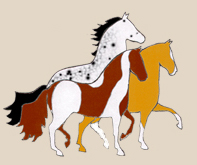 | ||||

For information on registering your Paso horse with Pintado or Atigrado characteristics
Contact us at:.
Welcome to the Official website of the Spanish Jennet Horse and
the Spanish Jennet Horse Society!
After the flamboyant Baroque period in Western Europe (2nd half of the 16th C to the beginning of the 18th C) most Europeans began to think of any flashy colored horse as vulgar. The Spaniards however, maintained a keen interest in the exotic colors and patterns, and if not for that interest many interesting colors and patterns might have vanished forever. In those times, the horse of Spain was not only bay, grey, black, chestnut, palomino and buckskin but he also appeared in the exotic patterns of Pintado (pinto) and Atigrado (tiger or what you may know as appaloosa).
In the Middle Ages, the Spanish Jennet Horse (Pinto Paso or Paso Tiger Horse) reflected his lofty Spanish heritage in his crisp, smooth gait, his proud and elegant carriage, and in his brilliant colors and flashy patterns. He was the mount of choice of all European nobility.
Today, a registered Spanish Jennet Horse (Pinto Paso or Paso Tiger Horse) is a predictable reflection of his historic predecessor. He sports an exotic patterned coat in a full spectrum of the usual colors of horses (the grey gene is not allowed), and he is heir to the stylish and smooth gait and distinctive conformation of the modern day Paso horses.
The Spanish Jennet Horse (Pinto Paso or Paso Tiger Horse) has a bold, energetic appearance. He possesses strength, stamina and elegance. His conformation is well proportioned, with moderation being the key concept. Extreme muscling is not typical and would detract from the desired appearance of great refinement. The Spanish Jennet (Pinto Paso or Paso Tiger Horse) is typically 13.2 to 15.2 hands. Increasing size tends to reduce the typical and much desired agility of the breed.
The head is medium in size, with a typically Spanish profile (slightly convex is not atypical), well chiseled and aristocratic, not course. The eyes are large, well spaced indicating intelligence, and having a pleasant, alert expression. Nostrils are oblong or crescent and dilatable. The muzzle is small and refined. Ears are medium in length and well shaped. The throat latch is well defined and clean.
The neck is medium in length and well arched but not heavy in the crest. It is set on high and in such a manner to allow a proud carriage with the ability to flex at the poll to a nearly vertical head carriage. Vertical neck insertions are not desirable as this does not produce angles that produce true Spanish Jennet gait. The neck is moderate in refinement, not too light in weight and not too coarse. It runs back to well defined withers.
The shoulder is well laid back allowing for freedom of movement and good reach.The chest is deep and the ribs well sprung. The back is strong and medium in length. The loins are broad and well muscled. The croup is somewhat angular but well rounded with the point of the hip well set in. The tail set is medium to low and the carriage of the tail is naturally “a la bandera”.
The legs of the Spanish Jennet (Pinto Paso or Paso Tiger Horse) are “dry” with prominent joints and refined long bones. The cannons are short and refined but extremely sturdy. Viewed head on when moving the Spanish Jennet may have a slight paddling of the front legs (this contributes to smoothness). Rear legs are set well under contributing to great agility. Hooves are small and tough. Mares and tails are full and long and double manes are not uncommon.
Temperaments are energetic, but gentle. The Spanish Jennet (Pinto Paso or Paso Tiger Horse) is highly intelligent and tractable; a real people pleasing horse. No small wonder the Spanish Jennet was the horse of choice of Medieval and Renaissance European nobility and royalty.
The Spanish Jennet is either Pintado or Atigrado. The Pintado is the Pinto Paso or Pinto Paso Fino. The Atigrado is the Paso Tiger Horse (Lp or Appaloosa patterns).
The birthright of the Spanish Jennet (Pinto Paso or Paso Tiger Horse) is the true Paso gait.
The Paso gait of the Spanish Jennet (like that of all Paso horses) is completely natural and frequently exhibited at birth. It is a four-beat, ever-so slightly lateral gait with each foot contacting the ground independently in a regular sequence at precise intervals creating a rapid, unbroken rhythm. The musical cadence produces the sound: taca-taca-taca-taca. Executed perfectly, the continuous rhythm is even in both cadence and impact. Footfall is in the same sequence as a natural equine walk: left rear, left fore, right rear, right fore. Propulsion is from the hind quarters and the horse's movement is absorbed in its back and loins, resulting in unequaled smoothness and comfort for the rider. The Paso gait is performed at two speeds and with varying degrees of collection: short gait, long gait. In all speeds of the gait, the rider should appear virtually motionless in the saddle, and there should be no perceptible up and down motion of the horse's croup. The Spanish Jennet also performs a flat walk, a collected walk, and a ground covering power walk. Many have wonderful canters or lopes and of course, like all horses, can do an all out gallop.

Breed Profile of the Spanish Jennet Horse